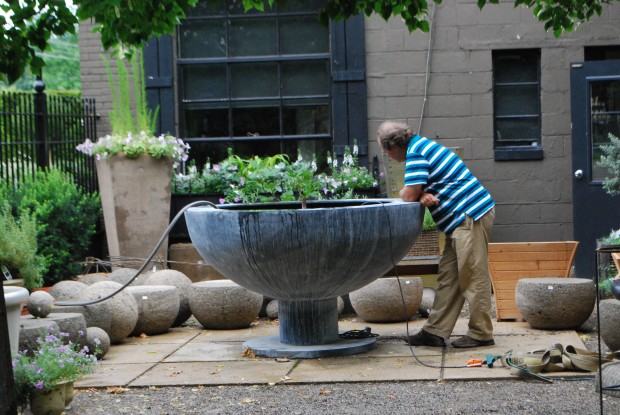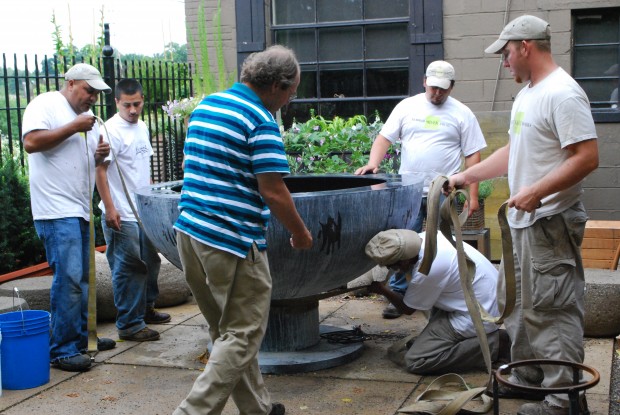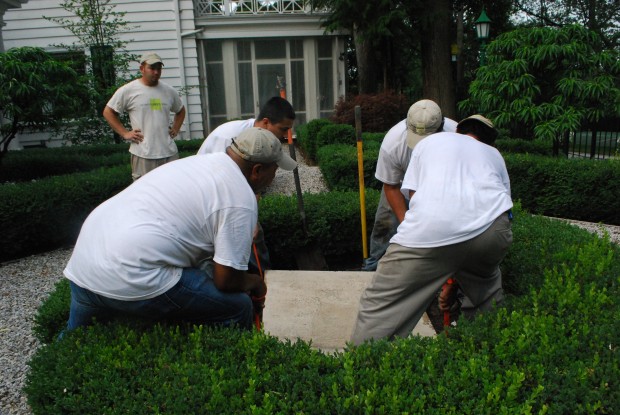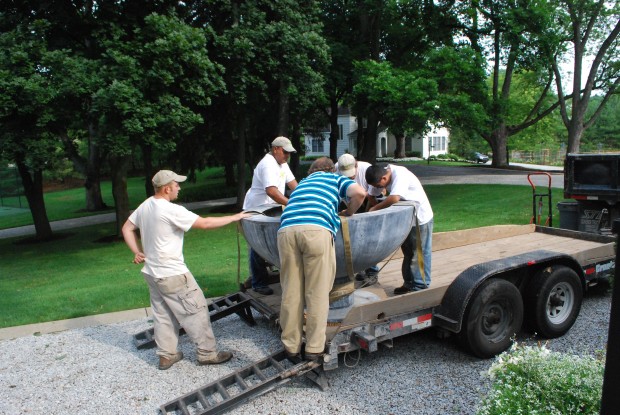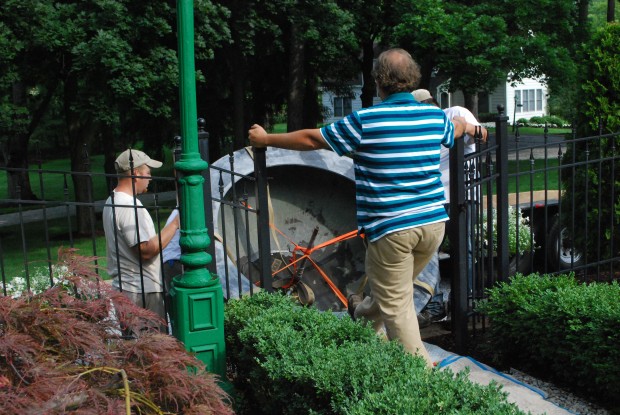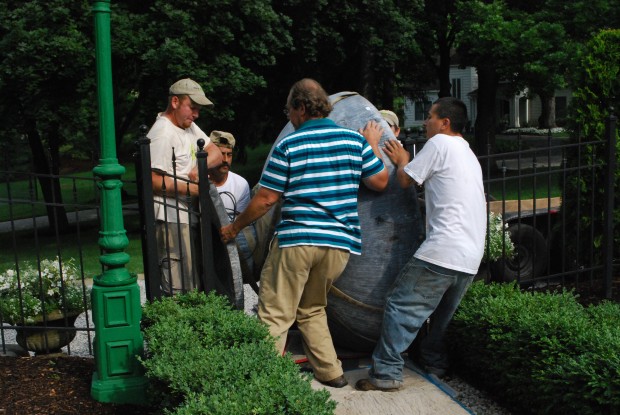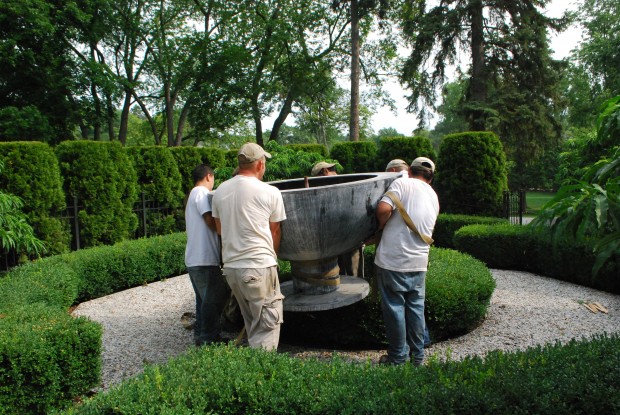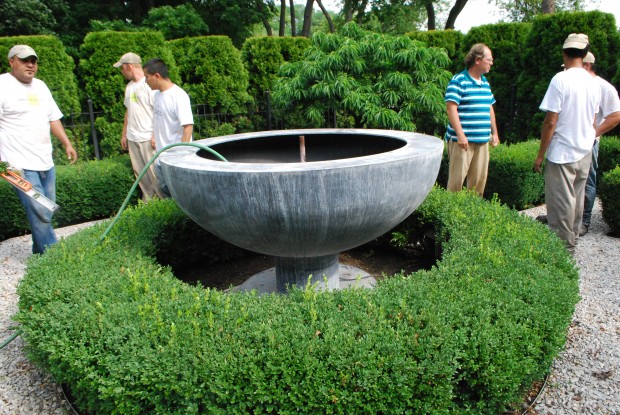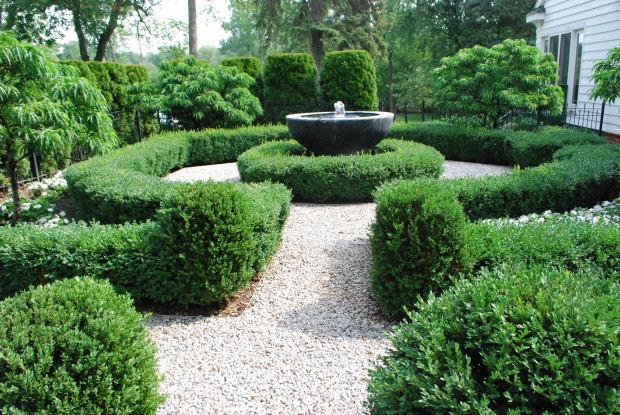A client who had looked a long time for a fountain fell hard for Buck’s contemporary steel creation. I ws more than a little surprised, considering her more traditional taste in garden ornament. But she was certain that this fountain was the perfect choice for her garden. The job of transporting and setting it in place fell to Steve. As you can see, he was planning the move.
Once he drained the fountain, he wrapped the fountain stem with heavy woven landscape straps. As the fountain weighed in at about 400 pounds, and the site was not particularly friendly to the use of a front end loader, we would have to move the piece by hand. 12 hands, to be exact. Each of three straps had a person at each end. The straps would be a lot simpler to grasp that the smooth side of the bowl. My crew can lift a lot, provided they are able to get a good grasp.
We excavates the soil from the spot where the fountain was to be placed, and filled it with coarse gravel. A square concrete tile was placed over top. This made it much easier to check to be sure the spot was level. It is also much easier to adjust this tile to get it level, as opposed to the fountain. It seemed like the fountain would be a good fit in this circle of boxwood-but we wouldn’t know for sure until we got it there.
The fountains we have manufactured at Branch of late come race ready. The jet inside this fountain is attached to a steel plate, and comes with a valve that regulates the height of the jet. Having a special event? Open up the valve. A tee fitting off the jet pipe is attached to the pump. The cord for the pump comes through a hole in the base of the fountain. The jet and pump assembly sits in the bottom of the fountain, making it easy to level the jet. All the customer needs to supply is a source of electricity.
Getting the fountain through the gate was a challenge. Luckily the gate itself was easy to lift off its hinges. Once the fountain base was resting on the second step up, the fountain would be flipped over on its side. The fountain has 4 eye hooks inside should the fountain ever have to be lifted. It proved handy for tying the jet in place for the move.
There were but a few inches of room to spare, but that proved to be enough. Luckily, any circular or hemispherical shape is not only very stable, but it is very strong. This steel is relatively thin, considering how large an object it is, but there was no worry that the edge would be damaged. At this point, we were rolling the fountain on its edge, rather than carrying it. I roll pots around the shop that I could never lift off the ground.
The last stage of the journey did involve lifting the fountain over a boxwood hedge. My crew made it look like no big deal.
They left me to fill the fountain-my pleasure, and my worry. If the level were the least bit off, the water would tell that tale. Water is always level-it’s people that get things crooked. As I cannot abide a statue or pot that isn’t sitting level, I was willing to wait.
I needn’t have worried. It read perfectly level to my eye. The wide rim of the fountain finishes the shape in a beautiful way, but it also masks any little bit it might be out of level. The fountain was filled with water to just under that rim. My client did very well with this-the fountain looks remarkably good in her garden. She had had an electrical box installed a long time ago, so an hour after our arrival, the fountain was running.
The entire garden made more visual sense given a centerpiece. The peach trees have a much more opulent and exotic look. I am standing on her porch, looking out. The water seems to be at just the right height. After trying the jet at a number of levels, she decided on this. Just enough height to make for a great sound.
My client thinks it looks like I designed this fountain especially for her garden. Since I would have never considered it for her, I realize that giving clients the chance to look without prejudice can result in an interesting outcome.
